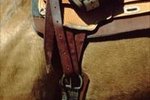The proper manner to cinch a Western saddle depends on the rigging you have on your saddle. You may learn to tie a cinch knot, use a cinch with a buckle or use both with a smart cinch. The rear cinch is optional on Western saddles and is used to keep the rear of the saddle from tipping upward during extreme activity, roping, barrel racing and fast stops.
Front Cinches
Cinch Strap with Latigo
Place your saddle pad on your horse and the Western saddle on the saddle pad.
Stand on the left side of your horse. Lift the left stirrup and hook it over the saddle horn to hold it out of your way.
Reach under your horse and grasp the cinch. Look at the cinch under your horse's heart girth to make certain it isn't twisted.
Pull the long, leather latigo attached to the cinch upward, making sure it is not twisted and insert the tip through the front rigging dee ring on the saddle from the outside to the inside and to the left of the ring toward your horse's front shoulder.
Make one to two additional wraps in the same manner as the first through the rigging dee ring if your latigo is very long. Pull each wrap of the leather snug, but not tight.
Tips
At this point, you can tie a cinch knot or buckle the cinch strap into the latigo, depending on your type of rigging.
Tying a Cinch Knot
Take the loose end of the latigo from the front of the dee ring and pass it horizontally across the wraps on the ring.
Pass the loose end from the right front through the ring and upward to the left side of the ring.
Insert the tip of the latigo down and through the horizontal loop you just made on the front of the ring. Pull the latigo end downward to make it snug.
Pull the first, innermost loop of the latigo through the cinch upward gently, then each additional wrap outwards from the first wrap to tighten the cinch. Pull the extra length through the rigging dee.
Cinch Buckles
Make the loops through the dee ring with the latigo as you do for a cinch knot.
Hook the tongue of a cinch buckle into the nearest hole in the latigo after you tighten it.
Pull the top latigo layer down so the tongue lodges against the buckle ring on the cinch.
Smart Cinches
Reach under your horse from his left side and grasp the latigo attached to the smart cinch.
Insert the latigo tip underneath the top roller on the smart cinch then through the top roller.
Bring the latigo tip upward and through the dee ring. Bring the latigo tip downward and through the bottom roller.
Tips
Make additional wraps in the same manner if your latigo is long, but only use the top roller on the smart cinch.
Pull the latigo tip upward to tighten the cinch.
Place the tongue of the smart cinch in the nearest hole of the latigo and tie a cinch knot in the latigo to secure it.
Double Rigging Saddles
Grasp the flank cinch underneath your horse and bring it to the left side of your horse.
Buckle the flank cinch into the left billet on the rear, left saddle dee. Adjust the flank cinch into a hole in the billet so the cinch is snug against your horse's belly.
Warnings
Do not allow the latigo's extra length to dangle underneath your horse. If you have a latigo holder on your saddle, insert the tip through it to keep it from frightening your horse or make additional wraps with the latigo so it is short enough not to hang below the cinch ring. A latigo holder is a flat piece of leather on the left side of the saddle horn with a slit in it to accommodate extra latigo length.
References
Writer Bio
Mary Lougee has been writing for over 10 years. She holds a Bachelor's Degree with a major in Management and a double minor in accounting and computer science. She loves writing about careers for busy families as well as family oriented planning, meals and activities for all ages.




